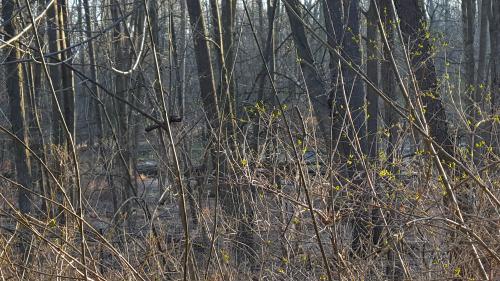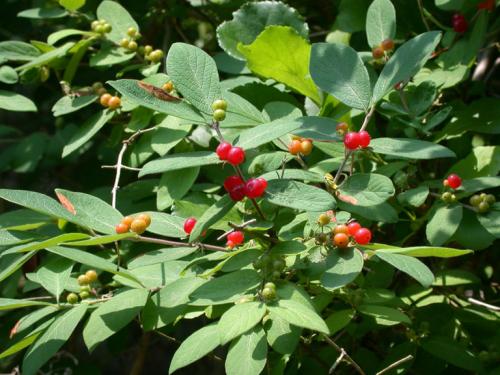Green isn’t always good
Those first signs of spring can reveal exotic invasive shrubs.
The days are finally on a warming trend, and the last piles of snow are melted away. Red twig and red osier dogwoods are blushing, and willow tops are showing yellow-gold. Now that the backyard lawns and winter wheat fields are greening up, we can also see a faint green tinge along many forest edges and roadways. But not all green is good. Some of the earliest shrubby bud-breakers are exotic invasive plants that need to be removed.
One particular set of exotic shrubs can easily be spied at this time of year along these forest edges. They are often referred to as Eurasian or bush honeysuckles. More specifically, there are multiple honeysuckle species that are included in this invasive threat: Amur (L. maackii), Tatarian (L. tatarica), Morrow’s (L. morrowii), and Bell’s (L. xbella, a hybrid of Tatarian and Morrow’s). Regardless of the species, they all have several features in common:
- Woody, shrubby growth habit, generally growing between six and 14 feet in height
- Leaves oppositely arranged on branches
- Abundant red or orange paired berries along the stem
- Small, fragrant pink or white (or occasionally red) flowers that bloom May-June
- Moderately tolerant to shade
All of these honeysuckles are especially successful in dominating natural areas because of their ability to leaf out extremely early in the spring and remain green well into the fall. This means they have a leg up in these settings, essentially shading and out-competing native plants. These honeysuckles can eventually form dense thickets where little else can grow, including tree regeneration.

Exotic invasive bush honeysuckles are easy to spot in the early spring when nothing else has begun to leaf out. Photo credit: Georgia Peterson, MSU Extension
These bushy pests got their foothold in North America when they were widely sold as an ornamental and advertised as good sources of wildlife food. The berries tend to persist into the fall when birds most often take advantage of them. Unfortunately, some studies suggest these berries are not as nutritious as native berries for birds. Additionally, the shrubs appear to offer less protection from predators during nesting season (see Illinois Natural History Survey study as an example).
Although they may be easy to spy in the spring, these exotic honeysuckles are not easy to get rid of. They are shallow-rooted, and young growth can easily be pulled in spring’s damp soil. Any remaining roots in the ground, however, will re-sprout easily. The same goes if the stems are clipped—sprouting is vigorous. Herbicide applications, especially after cutting stems, are usually needed to keep it from growing back. Note, always read and follow label directions, and obtain necessary permits or permissions if necessary, when applying chemical herbicides.

The berries may be attractive, but they aren’t the best food for birds. Photo credit: Stacey Leicht, University of Connecticut, Bugwood.org
Spring is a good time to be thinking about the best options for replacing these invaders once they’ve been removed. Nature abhors a vacuum, after all. Planning ahead by selecting native shrubs to replace these sudden open spaces will help keep future unwanted plants from taking over. Additionally, these native shrubs can offer multiple food and cover benefits for forest-dwelling wildlife, including songbirds. A small sample of recommended replacement native shrub species includes:
- Hawthorn (Crataegus spp.): There are many varieties of hawthorn, which can range from tall shrubs to small trees in form. They tolerate shade and a variety of soil types, but prefer more alkaline soil.
- American elderberry (Sambucus canadensis): Prefers partial sun and a slightly higher moisture content.
- Juneberry/Downy serviceberry (Amelanchier arborea): Actually a small tree. Will grow in both shady and sunny conditions across a range of soil types.
- Gray dogwood (Cornus racemosa): Tolerates a wide range of moisture, soil and sunlight exposures.
- Red-osier dogwood (Cornus sericea): Also can grow with some shade, but prefers wetter soils.
- Highbush cranberry (Viburnum opulus var americana): As with the dogwoods, this large bush can grow in part shade, but prefers wetter soils.
Unfortunately, most of these shrubs are also highly attractive to deer as browse. Be sure to protect new plantings from hungry mouths using fencing or repellants (see Protecting Your Seedlings from Deer and Rabbits for more information on options). For help on choosing and planting shrubs to replace those pesky exotic invasive plant species, contact Michigan State University Extension’s Master Gardener hotline at 888-MSUE4MI (888-678-3464).



 Print
Print Email
Email

